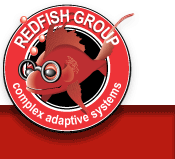|
| (1)
Complex Systems Visualization |
RedfishGroup's
3D interactive visualizations present the
dynamics of complex systems in meaningful
ways. Game-like
interactivity allows for exploration of
the phase-space of a system as agent and
environmental
parameters are changed on-the-fly.
Our
visualization toolset can integrate
with existing models or with custom
Redfish-designed agent-based models.
Example applications: Projects
Page
|
|
(2) Agent-Based
Modeling
Simulation
of your organization's processes via agent-based
modeling can give you a birds-eye
view of the workflows of your organization. A common
view can drive diverse stakeholders to common understandings
which allows them to move toward agreement on future
actions. Coupled with our expertise in 3D visualization,
solutions
found in agent-based modeling exercises can move
outside of the modeling group and diffuse throughout
your organization and to your collaboration partners.
Typical process flow on projects:
(3) Self-Organizing Systems Design
RedfishGroup can help you design
self-organizing software systems for your organization
or technical application. We leverage current
complex adaptive systems research conducted at Santa
Fe Institute and related institutions.
Self-organizing systems are
ideally suited for coordinating people,
software systems and/or business processes when
it is too costly, undesirable or impossible to
centralize the control of the system. Self-organizing systems
are often robust to unplanned failures and adaptive
to changing operational
environments. Contact us for a demonstration of
previous implementations.
Example Application: PeerPhoto:
a self-organizing peer2peer network for storing digital
photos. see research
|


